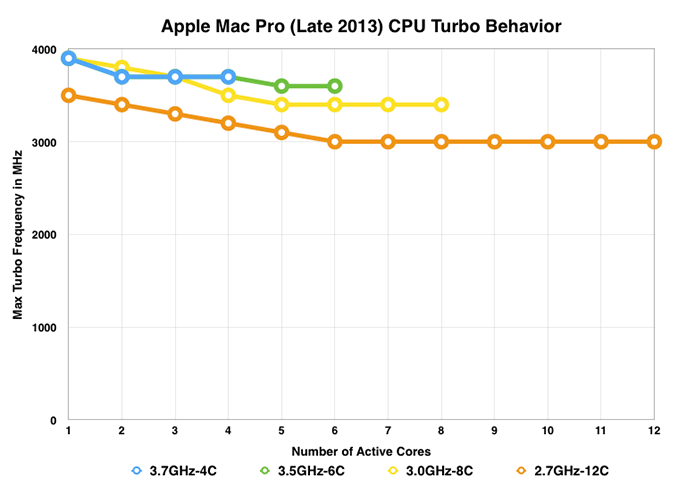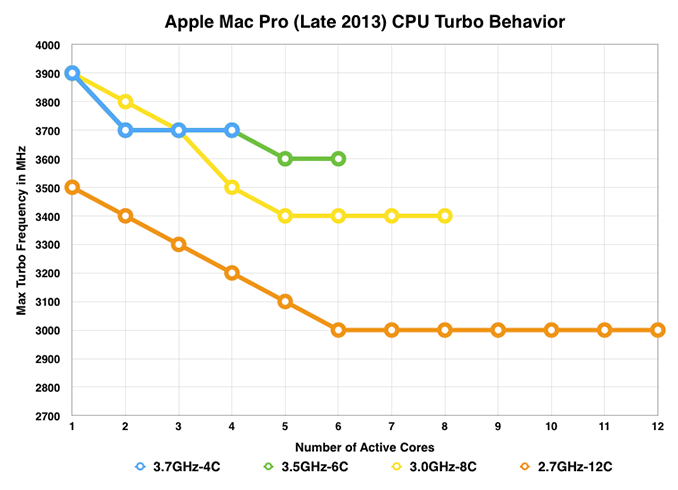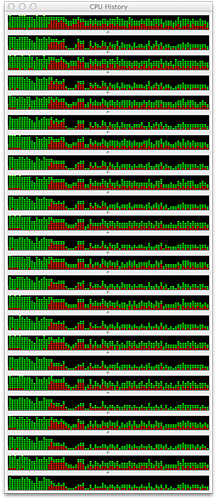The Mac Pro Review (Late 2013)
by Anand Lal Shimpi on December 31, 2013 3:18 PM ESTCPU Choices
Had I gotten around to publishing my rMBP review prior to this one you would’ve seen my praise Apple’s CPU selection abilities as of late. Outfitting all 15-inch rMBPs with Crystalwell was a very wise move on Apple’s part. With the Mac Pro the CPU selection is good, but the decision of what to buy is far more complex than in any other product line.
The Mac Pro not only serves as Apple’s ultra high end Mac, but it’s the only option if your needs exceed that of an iMac or 15-inch MacBook Pro. Literally anyone who needs more performance than Apple offers in an all-in-one or a notebook inevitably is pushed to consider the Mac Pro. With a relatively broad professional audience in mind, Apple offers more CPU options for the Mac Pro than on any other shipping Mac:
| Mac Pro (Late 2013) CPU Options | ||||||
| Intel CPU | Xeon E5-1620 v2 | Xeon E5-1650 v2 | Xeon E5-1680 v2 | Xeon E5-2697 v2 | ||
| Cores / Threads | 4 / 8 | 6 / 12 | 8 / 16 | 12 / 24 | ||
| CPU Base Clock | 3.7GHz | 3.5GHz | 3.0GHz | 2.7GHz | ||
| Max Turbo (1C) | 3.9GHz | 3.9GHz | 3.9GHz | 3.5GHz | ||
| L3 Cache | 10MB | 12MB | 25MB | 30MB | ||
| TDP | 130W | 130W | 130W | 130W | ||
| Intel SRP | $294 | $583 | ? | $2614 | ||
| Apple Upgrade Cost (Base Config) | - | +$500 | +$2000 | +3500 | ||
| Apple Upgrade Cost (High End Config) | - | - | +$1500 | +3000 | ||
There are four CPU options, each with varying core counts. The more cores you get, the lower your base CPU frequency is. In the old days, that would be the end of the discussion - you either choose more cores or more frequency, a tradeoff that is ultimately determined by your workload. Starting with its Nehalem architecture back in 2008, Intel introduced two key technologies that changed the face of multicore on the desktop: power gating and turbo boost. The former is a technology that can almost entirely remove power to a core (both active and leakage) when idle, while the second takes advantage of that freed up thermal budget to drive any active core(s) at higher frequencies. Subsequent implementations of Intel’s Turbo Boost technology have scaled the aggressiveness of this opportunistic frequency scaling, but the basic principle remains the same.
Apple advertises core count and base frequency for all of the Mac Pro CPU options, but to really understand what you’re getting yourself into you need to look at each CPU’s max turbo states vs. number of active cores. Neither Apple nor Intel do a great job of publicly exposing this information, Apple avoids doing so in order to keep things clean/simple, and Intel avoids doing so because perhaps it’s fun? Either way I’ve compiled the data on the four CPU options into the charts below.
I've left base clocks out of the graphs although you can see them noted in the legend at the bottom of each chart.
This first chart has the y-axis starting at 0MHz, but the next one is the more interesting as it starts at 2.7GHz and better illustrates/exaggerates the sort of frequency tradeoff you can expect vs. core count:
The 4, 6 and 8 core CPU options all offer the same peak single core frequency (3.9GHz). This is very important as single threaded performance remains the gate for system responsiveness outside of thread heavy applications. The 12-core CPU sacrifices around 10% of this peak single core performance.
Early on the 8-core CPU holds the advantage over the rest, being able to hit a higher 2-core max turbo. The octa-core’s crossover point happens at 3 active cores, beyond this point the quad and six core CPUs maintain a slight max turbo advantage.
The key takeaway here is that more cores isn’t necessarily better. You need to weigh the needs of your applications against the number of cores in your system. There is no one-size-fits-all answer here. For kicks I looked at the CPU load for a handful of my benchmarks:
![]()
![]()
![]()
Application version seems to have a huge impact on threading. Running our Photoshop benchmark on CS5 vs. CS6 is the difference between loading 2 - 8 cores vs. 3 - 10. The same is true if I compare Final Cut Pro 10.0 vs. 10.1; the latest version from Apple (optimized for the new Mac Pro), makes great use of all 12 cores/24 threads. Workload also has an impact. I took our old Final Cut Pro 10.0 benchmark (1080p) and ran it on 10.1, saw a maximum of 1217% CPU usage. I ran our new 4K benchmark on 10.1 and saw nearly full virtual core utilization (2114% CPU usage).
![]()
Final Cut Pro 10.0 - 1080p Benchmark
![]()
Final Cut Pro 10.1 - 1080p Benchmark
![]()
Final Cut Pro 10.1 - 4K Benchmark
Offline 3D rendering applications typically have the easiest time of chewing up tons of cores, while many others are likely better suited by having fewer cores running at a higher frequency. There's also a serious multitasking benefit if you're the type of person that runs multiple thread heavy workloads in parallel. It's pretty nice having a fairly responsive system while rendering a beefy 4K project in Final Cut Pro. The responsiveness comes courtesy of having a ton of cores in addition to extremely fast IO. That PCIe SSD definitely comes in handy.
If you want the best balance of heavily threaded performance without sacrificing performance in lighter workloads, the 8-core configuration seems to be the best bet. There are definitely bragging rights associated with the 12-core system, but unless you absolutely need a ton of cores you’re likely better suited by the 8-core configuration.













267 Comments
View All Comments
Ppietra - Friday, January 3, 2014 - link
An object with black color only implies that it absorbs visible light. Thermal radiation is mostly infrared not visible light, so being black has no consequence since there is nothing emitting visible radiation internally. Externally the surface is very reflective so no problem there either - not that there would be one it wasn’t reflectivecosmotic - Tuesday, December 31, 2013 - link
It would be nice to see storage performance of the Mac Pro SSD against RAID on mechanical disks and SSD disks from a previous Mac Pro model.cosmotic - Tuesday, December 31, 2013 - link
Including IOPSacrown - Tuesday, December 31, 2013 - link
The early 2008 Mac Pro does not support hyperthreadimg as your charts indicate. Of course I could just be doing something wrong with mine...acrown - Tuesday, December 31, 2013 - link
Stupid onscreen keyboard. I meant hyperthreading of course.Anand Lal Shimpi - Tuesday, December 31, 2013 - link
Whoops, you're right! Fixed :)acrown - Tuesday, December 31, 2013 - link
Great article by the way. I'm so on the fence about whether to get one to replace my current Mac Pro.The read is tempting me more and more though...
ananduser - Tuesday, December 31, 2013 - link
It's actually simple, it's the best OSX workstation for seemingly only Apple software that actually makes full use of the GPU setup.If your workflow revolves exclusively around FCX, it is the only workstation you'll need. If you're an average consumer wanting a powerful OSX machine you'd better get a consumer oriented imac.
PS: No need for me to mention that if you'll need CUDA and Windows then it's a bad buy.
akdj - Wednesday, January 1, 2014 - link
I'd expect OpenCL to become more and more and MORE ubiquitous as time marches on and Moore's law in relation to CPU slows...and more computing can be taken care of via screaming fast GPUs. Again. Early adopters. But CUDA/Windows options are aplenty. Just more expensive and without twin GPUs. Without PCIe storage. And.....oh yeah, their Windows boxes. At least with the MP you can run Windows...and perhaps, as we saw Adobe so quickly do with HiDPI support post rMBP release (along with hundreds of other apps and software companies)---hopefully Windows 8.2/9.x realizes the more significant 'all around' gains utilizing OpenCL (nVidia too?) than the very, VERY select software titles that take advantage of CUDA....and when they do, it's primal in comparison to what OpenCL opens the doors for. Literally. Everythingmoppop - Wednesday, January 1, 2014 - link
Considering CUDA is a GPGPU API there's no door that OpenCL opens that CUDA can't do...in fact, you could say that CUDA opens more doors on an Nvidia GPU. Nvidia also supports OpenCL since it was among the parties to help expand the api spec, but make no mistake, their flagship is CUDA.Aside from shunning Nvidia to market-segments whose software will be at least CUDA-accelerated (if there's GPU accelaration at all), my main beef with the Mac Pro, however, is that there are artificial limits placed by the design. Namely 1 CPU socket and only 4 DIMM slots.
For VFX/3DCG pros, the reality is that GPU rendering simply isn't there yet. Your PRMan, Mental Ray, V-Ray (not real-time V-Ray), Arnold, and Mantra renderers are still very much in the CPU world. When professionals buy a machine they need it to work now, and not 5 years from now. While the Mac Pro certainly appeals to portions of the pro market-segment, it was a simply foolish reason to castrate the Mac Pro.